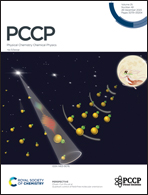Topological line defects in hexagonal SiC monolayer†
Abstract
Defect engineering of two-dimensional (2D) materials offers an unprecedented route to increase their functionality and broaden their applicability. In light of the recent synthesis of the 2D Silicon Carbide (SiC), a deep understanding of the effect of defects on the physical and chemical properties of this new SiC allotrope becomes highly desirable. This study investigates 585 extended line defects (ELDs) in hexagonal SiC considering three types of interstitial atom pairs (SiSi-, SiC-, and CC-ELD) and using computational methods like Density Functional Theory, Born–Oppenheimer Molecular Dynamics, and Kinetic Monte-Carlo (KMC). Results show that the formation of all ELD systems is endothermic, with the CC-ELD structure showing the highest stability at 300 K. To further characterize the ELDs, simulated scanning tunneling microscopy (STM) is employed, and successfully allow identify and distinguish the three types of ELDs. Although pristine SiC has a direct band gap of 2.48 eV, the presence of ELDs introduces mid-gap states derived from the pz orbitals at the defect sites. Furthermore, our findings reveal that the ELD region displays enhanced reactivity towards hydrogen adsorption, which was confirmed by KMC simulations. Overall, this research provides valuable insights into the structural, electronic, and reactivity properties of ELDs in hexagonal SiC monolayers and paves the way for potential applications in areas such as catalysis, optoelectronics, and surface science.



 Please wait while we load your content...
Please wait while we load your content...